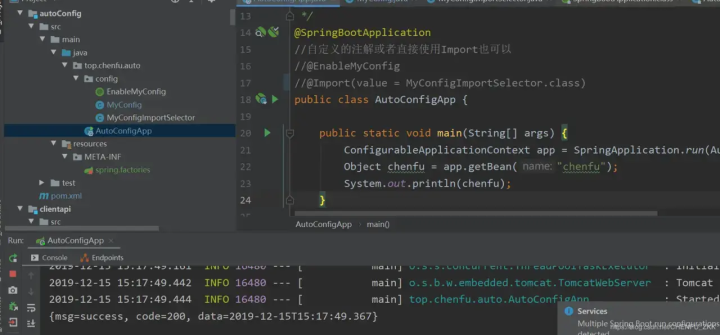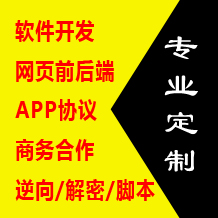该篇的主要内容
- Spring Boot的自动装配原理【有案例模拟】
- Spring Boot自动装配源码分析
SpringBoot中的自动装载原理
SpringBoot具备开箱即用的特点,它默默的帮我们做了很多事情【自动创建和装配很多对象】
自动装配的实现
主要是通过ImportSelector接口完成的自动装配
ImportSelector
ImportSelector接口是Spring导入外部配置的核心接口,在SpringBoot的自动化配置和@EnableXXX(功能性注解)中起到了决定性的作用。当在@Configuration标注的Class上使用@Import引入了一个 ImportSelector实现类后,会把实现类中返回的Class名称都定义为bean。
package org.springframework.context.annotation;
import org.springframework.core.type.AnnotationMetadata;
public interface ImportSelector {
/**
* Select and return the names of which class(es) should be imported based on
* the {@link AnnotationMetadata} of the importing @{@link Configuration} class.
*/
String[] selectImports(AnnotationMetadata importingClassMetadata);
}
该接口的继承关系图

DeferredImportSelector
由上图可知DeferredImportSelector接口继承自ImportSelector,它和ImportSelector的区别在于装载bean的时机上,DeferredImportSelector需要等所有的@Configuration都执行完毕后才会进行装载。
Spring Boot自动装配案例
项目案例传送门:autoConfig
案例主要代码
- 创建一个生产Bean的配置类,但是我们并不使用@Configuration注解来声明它。
public class MyConfig {
@Bean(value = "chenfu", name = "chenfu")
public Map<Object, Object> getMap() {
HashMap<Object, Object> map = new HashMap<>();
map.put("code", 200);
map.put("msg", "success");
String nowDate = LocalDateTime.now().format(DateTimeFormatter.ISO_LOCAL_DATE_TIME);
map.put("data", nowDate);
return map;
}
}
2.实现ImportSelector接口,返回我们上边的配置类名
public class MyConfigImportSelector implements ImportSelector {
@Override
public String[] selectImports(AnnotationMetadata annotationMetadata) {
// 返回配置名称
return new String[]{MyConfig.class.getName()};
}
}
3.运行测试
@SpringBootApplication
@Import(value = MyConfigImportSelector.class)
public class AutoConfigApp {
public static void main(String[] args) {
ConfigurableApplicationContext app = SpringApplication.run(AutoConfigApp.class, args);
Object chenfu = app.getBean("chenfu");
System.out.println(chenfu);
}
}
案例大体内容如上,通过案例可知经过Spring Boot自动装配的对象并没有使用Spring的对象创建注解声明 (@Controller,@Service,@Repostiroty),而是使用编程的方式动态的载入bean。在Spring Boor中对这些对象的解析步骤主要是在ConfigurationClassParser类的processImports方法内进行的
ImportSelector的解析过程
ConfigurationClassParser
ConfigurationClassParser类的源码
private void processImports(ConfigurationClass configClass, SourceClass currentSourceClass,
Collection<SourceClass> importCandidates, boolean checkForCircularImports) {
if (importCandidates.isEmpty()) {
return;
}
if (checkForCircularImports && isChainedImportOnStack(configClass)) {
this.problemReporter.error(new CircularImportProblem(configClass, this.importStack));
}
else {
this.importStack.push(configClass);
try {
for (SourceClass candidate : importCandidates) {
//对ImportSelector类型的类进行处理
if (candidate.isAssignable(ImportSelector.class)) {
// Candidate class is an ImportSelector -> delegate to it to determine imports
Class<?> candidateClass = candidate.loadClass();
ImportSelector selector = BeanUtils.instantiateClass(candidateClass, ImportSelector.class);
ParserStrategyUtils.invokeAwareMethods(
selector, this.environment, this.resourceLoader, this.registry);
//上边我们说过的另外一种Selector类型,可以理解为延迟加载
if (selector instanceof DeferredImportSelector) {
//该方法内部会将该Selector保存到一个集合【deferredImportSelectors】中
this.deferredImportSelectorHandler.handle(
configClass, (DeferredImportSelector) selector);
} else {
String[] importClassNames = selector.selectImports(currentSourceClass.getMetadata());
Collection<SourceClass> importSourceClasses = asSourceClasses(importClassNames);
processImports(configClass, currentSourceClass, importSourceClasses, false);
}
} else if (candidate.isAssignable(ImportBeanDefinitionRegistrar.class)) {
// Candidate class is an ImportBeanDefinitionRegistrar ->
// delegate to it to register additional bean definitions
Class<?> candidateClass = candidate.loadClass();
ImportBeanDefinitionRegistrar registrar =
BeanUtils.instantiateClass(candidateClass, ImportBeanDefinitionRegistrar.class);
ParserStrategyUtils.invokeAwareMethods(
registrar, this.environment, this.resourceLoader, this.registry);
configClass.addImportBeanDefinitionRegistrar(registrar, currentSourceClass.getMetadata());
} else {
// Candidate class not an ImportSelector or ImportBeanDefinitionRegistrar ->
// process it as an @Configuration class
// 直接把上边的官方英文注释硬翻译了,当前类不是ImportSelector或ImportBeanDefinitionRegistrar类型,直接让其走@Configuration类的处理流程
this.importStack.registerImport(
currentSourceClass.getMetadata(), candidate.getMetadata().getClassName());
processConfigurationClass(candidate.asConfigClass(configClass));
}
}
} catch (BeanDefinitionStoreException ex) {
throw ex;
} catch (Throwable ex) {
throw new BeanDefinitionStoreException(
"Failed to process import candidates for configuration class [" +
configClass.getMetadata().getClassName() + "]", ex);
} finally {
this.importStack.pop();
}
}
}
综上,大致流程就是ImportSelector接口的返回值会递归进行解析,然后把解析到的类全名最终按照 @Configuration进行处理。
ImportSelector总结
SpringBoot开箱即用的特点,很大程度上归功于ImportSelector。
Spring Boot源码分析
Spring Boot在Spring的基础上做了一些扩展。
- 在SpringBoot的SpringBootApplication注解中声明了一个 @EnableAutoConfiguration注解
@SpringBootConfiguration
@EnableAutoConfiguration
@ComponentScan(
excludeFilters = {@Filter(
type = FilterType.CUSTOM,
classes = {TypeExcludeFilter.class}
), @Filter(
type = FilterType.CUSTOM,
classes = {AutoConfigurationExcludeFilter.class}
)}
)
public @interface SpringBootApplication {
2.@EnableAutoConfiguration中通过Import引入了SpringBoot定义的@Import({
AutoConfigurationImportSelector.class})
@Import({AutoConfigurationImportSelector.class})
public @interface EnableAutoConfiguration {
接下来开始对
AutoConfigurationImportSelector进行源码分析
AutoConfigurationImportSelector
AutoConfigurationImportSelector是selectImports的实现类,我们来看selectImports方法
selectImports
public String[] selectImports(AnnotationMetadata annotationMetadata) {
if (!this.isEnabled(annotationMetadata)) {
return NO_IMPORTS;
} else {
AutoConfigurationMetadata autoConfigurationMetadata = AutoConfigurationMetadataLoader.loadMetadata(this.beanClassLoader);
AutoConfigurationImportSelector.AutoConfigurationEntry autoConfigurationEntry = this.getAutoConfigurationEntry(autoConfigurationMetadata, annotationMetadata);
return StringUtils.toStringArray(autoConfigurationEntry.getConfigurations());
}
}
该方法的主要逻辑都在getAutoConfigurationEntry方法内
getAutoConfigurationEntry
protected AutoConfigurationImportSelector.AutoConfigurationEntry getAutoConfigurationEntry(AutoConfigurationMetadata autoConfigurationMetadata, AnnotationMetadata annotationMetadata) {
if (!this.isEnabled(annotationMetadata)) {
return EMPTY_ENTRY;
} else {
AnnotationAttributes attributes = this.getAttributes(annotationMetadata);
// 2.1通过getCandidateConfigurations方法获取所有需要加载的bean
List<String> configurations = this.getCandidateConfigurations(annotationMetadata, attributes);
// 去重
configurations = this.removeDuplicates(configurations);
// 获取不需要加载的bean,我们可以通过spring.autoconfigure.exclude配置
Set<String> exclusions = this.getExclusions(annotationMetadata, attributes);
this.checkExcludedClasses(configurations, exclusions);
configurations.removeAll(exclusions);
configurations = this.filter(configurations, autoConfigurationMetadata);
// 发送事件,通知所有的AutoConfigurationImportListener进行监听
this.fireAutoConfigurationImportEvents(configurations, exclusions);
return new AutoConfigurationImportSelector.AutoConfigurationEntry(configurations, exclusions);
}
}
接下来再看一下上边源码中调用的
getCandidateConfigurations方法
getCandidateConfigurations
protected List<String> getCandidateConfigurations(AnnotationMetadata metadata, AnnotationAttributes attributes) {
// 这里的getSpringFactoriesLoaderFactoryClass()最终返回的是EnableAutoConfiguration.class
List<String> configurations = SpringFactoriesLoader.loadFactoryNames(this.getSpringFactoriesLoaderFactoryClass(), this.getBeanClassLoader());
Assert.notEmpty(configurations, "No auto configuration classes found in META-INF/spring.factories. If you are using a custom packaging, make sure that file is correct.");
return configurations;
}
从上面的逻辑可以看出,终获取bean的渠道在
SpringFactoriesLoader.loadFactoryNames内SpringFactoriesLoader.loadFactoryNames(this.getSpringFactoriesLoaderFactoryClass(), this.getBeanClassLoader());
SpringFactoriesLoader
loadFactoryNames
public static List<String> loadFactoryNames(Class<?> factoryClass, @Nullable ClassLoader classLoader) {
// 通过factoryClassName获取相应的bean全称
String factoryClassName = factoryClass.getName();
return (List)loadSpringFactories(classLoader).getOrDefault(factoryClassName, Collections.emptyList());
}
loadSpringFactories
private static Map<String, List<String>> loadSpringFactories(@Nullable ClassLoader classLoader) {
MultiValueMap<String, String> result = (MultiValueMap)cache.get(classLoader);
if (result != null) {
return result;
} else {
try {
// 获取项目中所有META-INF/spring.factories文件,将其组装成Map
Enumeration<URL> urls = classLoader != null ? classLoader.getResources("META-INF/spring.factories") : ClassLoader.getSystemResources("META-INF/spring.factories");
LinkedMultiValueMap result = new LinkedMultiValueMap();
while(urls.hasMoreElements()) {
URL url = (URL)urls.nextElement();
UrlResource resource = new UrlResource(url);
Properties properties = PropertiesLoaderUtils.loadProperties(resource);
Iterator var6 = properties.entrySet().iterator();
while(var6.hasNext()) {
Entry<?, ?> entry = (Entry)var6.next();
String factoryClassName = ((String)entry.getKey()).trim();
String[] var9 = StringUtils.commaDelimitedListToStringArray((String)entry.getValue());
int var10 = var9.length;
for(int var11 = 0; var11 < var10; ++var11) {
String factoryName = var9[var11];
result.add(factoryClassName, factoryName.trim());
}
}
}
cache.put(classLoader, result);
return result;
} catch (IOException var13) {
throw new IllegalArgumentException("Unable to load factories from location [META-INF/spring.factories]", var13);
}
}
}
每个jar包都可以定义自己的META-INF/spring.factories,在该jar被加载的同时 spring.factories里面定义的 bean就会被自动加载。我们可以来看一下Spring Boot的该配置文件内容【只拿出部分内容】
# Auto Configuration Import Filters org.springframework.boot.autoconfigure.AutoConfigurationImportFilter=\ org.springframework.boot.autoconfigure.condition.OnBeanCondition,\ org.springframework.boot.autoconfigure.condition.OnClassCondition,\ org.springframework.boot.autoconfigure.condition.OnWebApplicationCondition # Auto Configure org.springframework.boot.autoconfigure.EnableAutoConfiguration=\ org.springframework.boot.autoconfigure.admin.SpringApplicationAdminJmxAutoConfiguration,\ org.springframework.boot.autoconfigure.aop.AopAutoConfiguration,\ org.springframework.boot.autoconfigure.amqp.RabbitAutoConfiguration,\
故,我们可以对上边的案例进行改造,在resouces目录下创建该文件,然后添加如下内容
org.springframework.boot.autoconfigure.EnableAutoConfiguration=\ top.chenfu.auto.config.MyConfig
去掉启动类中的@import或者自定义@EnableXXX注解





